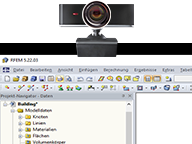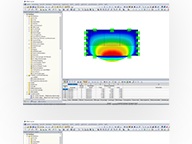Reinforced concrete design according to the model column method or the nominal curvature method
- Full integration in RFEM/RSTAB with import of geometry and load case data
- Automatic selection of members for design according to specified criteria (e.g. only vertical members)
- In connection with the extension EC2 for RFEM/RSTAB, you can perform the design of reinforced concrete compression elements according to the method based on nominal curvature in compliance with EN 1992 -1‑1:2004 (Eurocode 2) and the following National Annexes:
-
DIN EN 1992-1-1/NA/A1:2015-12 (Germany)
-
ÖNORM B 1992-1-1:2018-01 (Austria)
-
Belgium NBN EN 1992-1-1 ANB:2010 for design at normal temperature, and NBN EN 1992-1-2 ANB:2010 for fire resistance design (Belgium)
-
BDS EN 1992-1-1:2005/NA:2011 (Bulgaria)
-
EN 1992-1-1 DK NA:2013 (Denmark)
-
NF EN 1992-1-1/NA:2016-03 (France)
-
SFS EN 1992-1-1/NA:2007-10 (Finland)
-
UNI EN 1992-1-1/NA:2007-07 (Italy)
-
LVS EN 1992-1-1:2005/NA:2014 (Latvia)
-
LST EN 1992-1-1:2005/NA:2011 (Lithuania)
-
MS EN 1992-1-1:2010 (Malaysia)
-
NEN-EN 1992-1-1+C2:2011/NB:2016 (Netherlands)
-
NS EN 1992-1 -1:2004-NA:2008 (Norway)
-
PN EN 1992-1-1/NA:2010 (Poland)
-
NP EN 1992-1-1/NA:2010-02 (Portugal)
-
SR EN 1992-1-1:2004/NA:2008 (Romania)
-
SS EN 1992-1-1/NA:2008 (Sweden)
-
SS EN 1992-1-1/NA:2008-06 (Singapore)
-
STN EN 1992-1-1/NA:2008-06 (Slovakia)
-
SIST EN 1992-1-1:2005/A101:2006 (Slovenia)
-
UNE EN 1992-1-1/NA:2013 (Spain)
-
CSN EN 1992-1-1/NA:2016-05 (Czech Republic)
-
BS EN 1992-1-1:2004/NA:2005 (United Kingdom)
-
TKP EN 1992-1-1:2009 (Belarus)
-
CYS EN 1992-1-1:2004/NA:2009 (Cyprus)
-
- In addition to the National Annexes (NA) listed above, you can define a specific NA, applying user-defined limit values and parameters.
- Optional consideration of creep
- Diagram-based determination of buckling lengths and slenderness from the restraint ratios of columns
- Automatic determination of ordinary and unintentional eccentricity from additionally available eccentricity according to the second-order analysis
- Design of monolithic structures and precast elements
- Analysis with regard to the standard reinforced concrete design
- Determination of internal forces according to the linear static analysis and the second-order analysis
- Analysis of governing design locations along the column due to existing loading
- Output of the required longitudinal and stirrup reinforcement
- Fire resistance design according to the simplified method (zone method) according to EN 1992-1-2 allowing the fire resistance design of brackets.
- Fire resistance design with optional longitudinal reinforcement design according to DIN 4102-22:2004 or DIN 4102-4:2004, Table 31
- Longitudinal and link reinforcement proposal with graphic display in 3D rendering
- Summary of design ratios, including all design details
- Graphical representation of relevant design details in RFEM/RSTAB work window
The members to be designed are directly imported from RFEM/RSTAB. Load cases, load combinations, and result combinations are assigned, which result in the linear-elastically determined internal forces on the selected members. When considering creeping, the creep-producing load must also be defined. The RFEM/RSTAB materials are preset but can be adjusted in RF-/CONCRETE Columns. The material properties listed in the respective standard are included in the material library.
You can easily define constructional properties of columns as well as other details for determining the required longitudinal and shear reinforcement. The effective length factor ß is to be defined manually, determined automatically by the module, or imported from the RF-STABILITY/RSBUCK add-on module.
The fire resistance design according to EN 1992-1-2 requires various specifications; for example, determination of cross-section sides where burn-off occurs.
For the bending failure design, the governing locations of the column are analyzed for axial force and moments. In addition, locations with extreme values of shear forces are considered for the shear resistance design. During the calculation, it is determined whether a standard design is sufficient or whether the column with the moments has to be designed according to the second-order theory. These moments are then determined based on the previously entered specifications. The calculation has four parts:
- Load-independent calculation steps
- Iterative determination of governing loading taking into account a varying required reinforcement
- Determination of the designed reinforcement for governing internal forces
- Safety determination of all acting internal forces, including the designed reinforcement
In this way, RF-/CONCRETE Columns provides a complete solution of an optimized reinforcement concept and the resulting load actions.
After the calculation, the results are displayed in clearly arranged tables. Each intermediate value is listed, making the design checks transparent.
The module creates a reinforcement concept for the longitudinal and the shear reinforcement considering all constructional specifications. The reinforcement is represented by a 3D drawing, including dimensions. You can adjust the reinforcement concept to your individual requirements. A 3D graphic shows the exact distribution of strain and stress across the cross-section.
If any of the fire resistance designs is not fulfilled, RF-/CONCRETE Columns increases the required reinforcement until either all designs are performed successfully or no reinforcement layout can be found. You can visualize the columns and their reinforcement in the 3D rendering as well as in the work window of RFEM/RSTAB. In addition to the input and result data including design details displayed in tables, you can add all graphics into the printout report. This way, comprehensible and clearly arranged documentation is guaranteed.

The price is valid for United States.







.png?mw=192&hash=f63e4a3f1836233005de32f60201d5392e507cf1)



